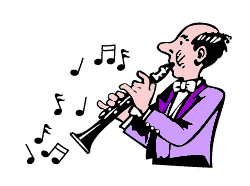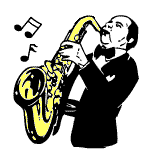(Down - Up - Top)
SAX 6b.2 - Overtones on the Clarinet
Some of the Overtones on the Saxophone become sharp as you go higher compared to the tempered 'normal' notes on the instrument. 
On the clarinet on the other hand Overtones become increasingly flatter.
The first interval from Fundamental to Overtone No.3 is exactly in tune, and that is the main thing as far as playing the clarinet is concerned.
But then successive intervals between Overtones each are about a semitone smaller then are supposed to be according to the mathematics.
From the low E fundamental the Overtone No.5 is clearly a G instead of G#. Overtone No.7 is a C instead of a D, Overtone No.9 is an E - Eb instead of a F#.
Here a Table showing the Overtones for the Fundamentals E, F and F#. The pitches are as I find them on my own clarinet. Minor differences may occur on different instruments.
(Above Overtone No.11 are more Overtones but very close together, a tone or less apart.)
Overtones on the Clarinet
|
Overtone 11
|
G
|
Ab
|
A (+)
|
|
Overtone 9
|
E (-)
|
F (-)
|
F#
|
|
Overtone 7
|
C
|
Db
|
D
|
|
Overtone 5
|
G
|
Ab
|
A
|
|
Overtone 3
|
B
|
C
|
C#
|
|
Fundamental 1
|
E
|
F
|
F#
|
(Down - Up - Top)
SAX 6b.3 - Benefit of Overtone Practice
Through my experience as a teacher I have found that students can produce high Overtones on the clarinet without too much difficulty once they have developed their embouchure and have gained some notion of voicing and 'thinking' the pitch. But no way can they produce similar high Overtones on the saxophone. 
This suggests that you do not develop the vital Head Register voicings (required for the saxophone) by practising clarinet Overtones.
The reason for this probably lies in the totally different acoustic natures of these two instruments.
Overtone practice on the saxophone is therefore essential for the development of the Head Register and for smooth integration of Head and Chest Register.
Overtone practice on the clarinet is perfectly OK for tone practice of clarinet players. Less pronounced, and perhaps slightly different, oral tract movements seem to be required for the clarinet.
For saxophone players the main benefit of playing clarinet Overtones lies in learning to think the note pitch before playing it (the Overtones on the clarinet are further apart than on the saxophone).
- Going from Overtone No.3 to No.5 you must think a minor 6th up (first two notes of 'Black Orpheus') other wise the Overtone will not come out.
- likewise from Overtone No.5 to No.7 you must first think a perfect 4th up (first two notes of 'Amazing Grace')